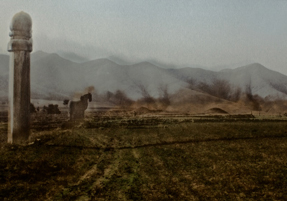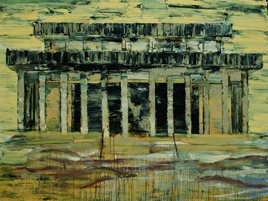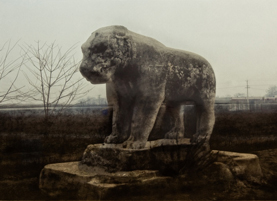contact rubrique Agenda Culturel : Cette adresse e-mail est protégée contre les robots spammeurs. Vous devez activer le JavaScript pour la visualiser.
联系方式 : Cette adresse e-mail est protégée contre les robots spammeurs. Vous devez activer le JavaScript pour la visualiser.
“Wu Xiaochuan - 武小川” The Demise of the Things - 逝者如斯 854
au White Box Museum of Art, Beijing - 白盒子艺术馆, 北京
du 9 mars au 9 avril 2013 - 2013年3月9日–4月9日
© Piao Song Yi



légendes de gauche à droite
1/ Wu Xiaochuan - 武小川, Superposition : The Chong Imperial Mausoleum - 《叠加:崇陵》, photograph 艺术微喷, 40×60cm, 2013.
2/ Wu Xiaochuan - 武小川, Memorial Hall - 《纪念堂》, acrylic on canvas - 布面丙烯, 180×240cm, 2013.
3/ Wu Xiaochuan - 武小川, Superposition : The Xian Imperial Mausoleum - 《叠加:献陵》, photograph - 艺术微喷, 40×60cm, 2013.
présentation :
Curator - 策展人: Dai Zhuoqun - 戴卓群
Artists - 参展艺术家 : Wu Xiaochuan - 武小川
Preface of Exhibition : The Demise Of The Things - 展览前言 : 逝者如斯
by Dai Zhuoqun - 文 / 戴卓群
Wu Xiaochuan is a scholar-type artist with a very distinctive disposition. He pursues knowledge by studying the very nature of things and makes reflections on social reality, cultural issues and his inner self. His creations forge a unique quality between introspection and outer-appearance. On the one hand he confines himself in the hidden stream of consciousness of life experience, tasting such fickle consciousness and emotion as death, conflict, anxiety and trauma. Yet in another state he takes a positive and active attitude, making extensive reflections and dissections of the essentials of human civilization and values. Undoubtedly, Mr. Wu is a thorough pessimist in his heart of hearts. And it is this pessimism and void that endows him with a powerful personality charm and a complicated and mutually-complementary multiple cultural individuality.
Wu Xiaochuan is a man who likes to listen to the voice of his inner self and keeps sensitive to and sympathetic with things which have passed. In his early works he shows undying pity and pain about the death of individuals. In this period he transformed his worship of human bodies with temperature and strength to his stubborn depiction of the death, bodies, carcasses and skeletons of human beings and animals. All this adheres to the artist’s self examination and his comprehension of life.
What is it after all that is elapsing? With the deepening of the artist’s self experience of life, the change of his artistic creation has become self-activated reality. Judging from a series of his creations such as expressions, human bodies, portraits, horse heads, skulls and animal skeletons, all the exterior things have become objects of the introspection of his inner world. The construction and confirmation of the subjectivity of personal value is naturally activated by the complicated and ever-changing exterior reality and environment of situation, history, people and things. This is a two-way process of both from interior to exterior and from exterior to interior. Here, the real convergence and impact of physical experience and exterior world is the basis of the subjective reflection and value correction in the universal sense.
“Confucius exclaimed at the flowing river: Time flies like this incessant stream, day and night.” — from The Analects. Time changes; matter transmigrates; life disappears in a twinkle; nature multiplies in an endless succession. In the Buddhist meditation, Mr. Wu fulfils the emancipation of himself and comprehends the true essence of liberty, because only when a person is capable of thinking freely can he really embrace liberty. His recent work of Rainbow Series reveals the contemporary mentality and awareness of artists. His series of Incomplete Form — Portraits of 10 Kings depict the images of 10 state heads who died in an abnormal way: John Fitzgerald Kennedy, Sadat, Yitzhak Rabin, Ceausescu, Kaczynski, Liu Weihuang, Gandhi, Roh Moo Hyun, Saddam Hussein and Omar Mouammer al Gaddafi. He turns the grand narration in the context of historical determinism into the introspection of individual lives and existence.
As a person who was born and grew up here in central Shaanxi, Wu Xiaochuan has always been haunted by the local humanism in his mind and emotion. He has a thorough knowledge of the geography of the Central Shaanxi Plain is very familiar with the Han and Tang civilization centering on Xi’an and Xianyang. Even in his early paintings, the emperors’ mausoleums and Buddhist pagodas were focused and depicted. In recent years the artist has discovered a new work path based on archaeology and artistic anthropology. He enters into a brand-new examination of localism and material culture with the method of field investigation and the medium of concept photography. In his series of Piling Up Mr. Wu piles up the transparent negatives of the pictures of historical remains taken by a Frenchman and a Japanese in 1920s with the contemporary scenes. He put them in the same viewing frame and had them photographed anew. As a result the pictures seem to be true to life, but are actually not. They seem to be dream-like scenes which are neither contemporary nor ancient. Here, the images in history have become the materialized objects in the realistic video images.
武小川是一位气质非常鲜明的知识分子型艺术家,格物致知,品物流形,置身于体制内反思社会现实、文化问题及自我状态。武小川的创作亦在内省与外观之间建构其独具的特质,一方面,他囚禁自我于生命体验的意识潜流中,孤独地詆添着关于死亡、冲突、焦灼、创伤等居变不定的意识与情感;而在另一种状态下,他又抱持积极入世的昂扬立场,展开对人类文明价值内核极为宏观和庞大的反思与解剖。在骨子里,武小川无疑是一个彻底的悲观主义者,而正是这种悲观虚空的底蕴,却另他独具了一种刚健的性格魅力,构成其纠结而又互补的多重文化人格。
武小川是一个善于聆听自我内心声音的人,一个对一切消逝之物保持敏感和悲悯的人。在他的早期创作中,对个体生命消亡的强烈触痛成为挥之不去的情絮,这一时期,从对鲜活的充满温度与力量的身体的膜拜与冲动,到持续描摹各种人与动物的死亡、躯体、骷髅与骨架,无不紧紧地附着在艺术家对生命内在自我的审视与体悟中。
究竟什么正在消逝?随着艺术家自我人生经历与体验的深入,创作面貌的变迁成为自发自为的现实,从表情、身体、人像到马首、头骨、动物骨架等一系列创作,一切外部的事物成为武小川借以开展自我内在反思的客体。佛经中讲“物无自性”,做为个人价值主体性的建构和确认,必然地经由具体的情景、历史、人与事等一切错综复杂、瞬息万变的外部现实和环境来生发,这是一个籍外而内,又由内而外的双向过程。在这里,肉身体验与外部现实产生
了真正意义上的交汇与激荡,这是一切做为非普遍意义的主体反思和价值纠证的基础。
“子在川上曰:‘逝者如斯夫!不舍昼夜。’——《论语·子罕》”。时光交替变迁,物质蜕化轮回,生命转瞬即逝,自然生生不息。在这样禅修式的参悟中,武小川完成了对自我的解放并领会自由的真谛,因为只有拥有自由思想能力的人才能真正地拥抱自由。新近创作的“彩虹系列”昭然若揭了艺术家当下的心态与觉悟,其令人触目的“不完整的形式,十王像”系列作品,则分别绘制了肯尼迪、萨达特、拉宾、齐奥塞斯库、卡钦斯基、刘卫黄、拉甘地、卢武铉、萨达姆和卡扎菲一共十位非正常死亡的国家元首肖像,将往常历史决定论语境中的宏大叙事幻化成为对个体生命与存在的内在省视。
做为一个生于斯、长于斯的关中人,地域文脉亦成为始终萦绕在武小川思想与情感中的另一条重要线索。武小川对关中平原的山川地理了如指掌,对围绕长安咸阳为中心的汉唐文明如数家珍。早在之前的绘画创作中,历代帝王的陵墓以及佛塔已是其关注和描绘的对象,近年来,艺术家更是探索了一种建立在考古与艺术人类学性质下的工作路径,以田野考察的方法和观念摄影为媒介进入对地方主义和物质文化的全新审视,在“叠加”系列作品中,武小川将法国人沙畹和日本人足立喜六拍摄于20世纪初的帝陵、造像等古迹黑白照片的透明菲林底版与当下现实景象叠加在镜头的取景框中,并将其重新拍摄,产生一种似是而非、非今非古的梦幻情景,如露亦如电,在这里,历史中的影像成为了一种现实影像中的物质化对象。